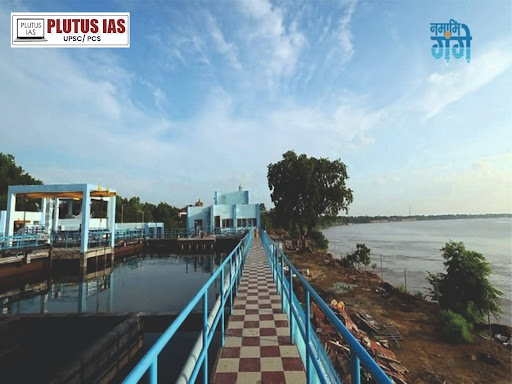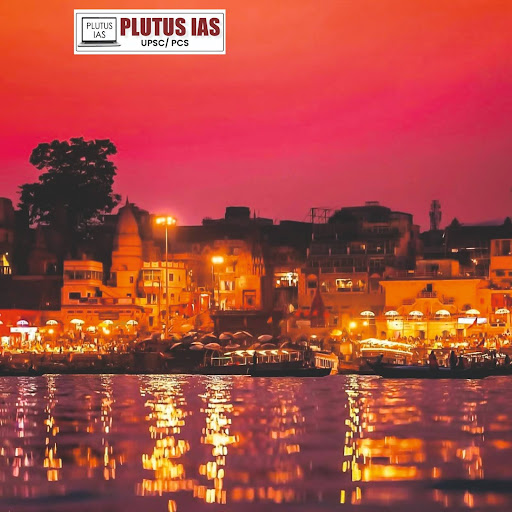15 Mar Namami Gange: Transformative Milestones in Ganga Rejuvenation”
This article covers “Daily Current Affairs” and Topic details “Namami Gange: Transformative Milestones in Ganga Rejuvenation”
SYLLABUS MAPPING:
GS-3-Environment: Water pollution: Prevention and control.
FOR PRELIMS
What is the Namami Gange Programme (NGP) and its components and objectives?
FOR MAINS
Key achievements Namami Gange Programme (NGP) and its challenges and measures to improve the Ganga effort.
Why in the News?
The Namami Gange Programme (NGP), a flagship initiative by the Government of India, has made significant progress in conserving and rejuvenating the Ganga River. With an investment of Rs. 40,000 crore, over 300 projects have been completed. Initially allocated Rs. 20,000 crore, the budget was later extended to Rs. 22,500 crore to ensure long-term sustainability. The program focuses on reducing pollution, enhancing biodiversity, and strengthening people’s connection with the river, as highlighted in a recent statement by the Ministry of Jal Shakti.

The National Mission for Clean Ganga (NMCG):
| Category | Details |
|---|---|
| Formation | – Registered: 12th August 2011 under Societies Registration Act, 1860. – Originally implemented under: the National Ganga River Basin Authority (NGRBA). – NGRBA dissolved on: 7th October 2016, replaced by National Ganga Council under EPA, 1986. |
| Composition | – Two-tier management structure: 1. Governing Council 2. Executive Committee – Director General (DG) of NMCG: Additional Secretary, Government of India. |
| Constituents of NMCG | – Five-tier governance structure: 1. National Ganga Council (Chairman: Prime Minister of India). 2. Empowered Task Force (ETF) on River Ganga (Chairman: Union Minister of Jal Shakti). 3. National Mission for Clean Ganga (NMCG) (Implementation arm). 4. State Ganga Committees (State-level coordination). 5. District Ganga Committees (Local-level implementation). |
| Responsibilities | – Approval of projects up to Rs. 1000 crore by the Executive Committee. – Coordination with State Programme Management Groups (SPMGs) for effective implementation. – Ensuring pollution abatement & rejuvenation of River Ganga. – Bringing all stakeholders together for a holistic approach. |
| Main Functions | – Prevention, control & abatement of pollution in the Ganga. – Ensuring continuous & adequate water flow for rejuvenation. – Implementation of Namami Gange Programme. – Biodiversity conservation & ecological restoration. – Public engagement & awareness campaigns. – Monitoring and enforcement of environmental laws related to Ganga. |
Key Achievements Under the Namami Gange Programme
1. Project Implementation & Investment: A total of 492 projects were initiated across various sectors, with an investment of Rs. 40,121.48 crore. 307 projects completed and operational, significantly enhancing the river’s health.
2. Sewage Infrastructure & Pollution Control: 206 sewage infrastructure projects were sanctioned at Rs. 33,003.63 crore, and 127 projects were completed. A sewage treatment capacity of 6,255 MLD was targeted, and 3,446 MLD capacity is operational.
3. Industrial Pollution Abatement: Jajmau CETP (20 MLD) and Mathura CETP (6.25 MLD) completed. Banther CETP (4.5 MLD) in progress plants.
4. Ecological & Biodiversity Conservation: 56 projects for biodiversity and afforestation, with 39 completed at Rs. 905.62 crore. Seven biodiversity parks were developed in Uttar Pradesh. 33,024 hectares afforested with an expenditure of Rs. 398 crore, enhancing the river’s green cover. 143.8 lakh Indian Major Carp (IMC) fingerlings released to support fish biodiversity and local livelihoods.
5. Sustainable Water Management & Treated Water Reuse: The National Framework for Safe Reuse of Treated Water was introduced to promote wastewater recycling and reduce freshwater dependence.
Key Initiatives and Bodies for Ganga Rejuvenation
Ganga Action Plan (GAP) – 1986: The first major initiative launched to reduce pollution by intercepting, diverting, and treating sewage and industrial waste. Covered 25 cities along the Ganga, setting up 35 sewage treatment plants (STPs) with a total capacity of 865 MLD.
National Ganga River Basin Authority (NGRBA) – 2009: Established as an empowered authority to take a holistic approach to Ganga conservation. Declared the Ganga as India’s “National River.” Introduced river basin management strategies instead of isolated pollution control measures. Replaced in 2016 by the National Ganga Council (NGC) for better implementation.
National Mission for Clean Ganga (NMCG) – 2011: Functions as the implementation arm of the National Ganga Council. Oversees the Namami Gange Programme, the Indian government’s flagship river-cleaning initiative.
Focuses on:
Sewage treatment infrastructure (Over 200 STPs sanctioned, 127 completed).
River-surface cleaning (Introduced bioremediation, trash skimmers).
Biodiversity conservation (Gangetic dolphin population increased from 3,330 to 3,936).
Public awareness campaigns and stakeholder engagement.
Challenges in Ganga Clean-Up Efforts:
Inadequate Sewage Treatment Capacity – The Ganga receives 12,000 MLD of sewage daily, but the treatment capacity is only 5,000 MLD, leading to massive pollution.
Industrial Pollution – Over 1,100 industrial units along the river discharge untreated effluents, significantly deteriorating water quality.
Agricultural Runoff Contamination – Agricultural runoff contributes over 10,000 tonnes of fertilizers and pesticides annually, increasing nitrate and phosphate levels, which cause algal blooms and reduce oxygen levels.
Religious and Cultural Pollution – Every year, over 1 lakh (100,000) human and animal remains are immersed in the river, along with 80 lakh idols and 50,000 tonnes of religious waste, especially during festivals like Kumbh Mela.
Solid Waste Dumping—More than 3,000 tonnes of solid waste, including plastics, polythene, and other non-biodegradable materials, is dumped daily into the Ganga from major cities.
Delayed Infrastructure Development – Out of 206 sewage treatment plants (STPs) sanctioned under the Namami Gange Programme, only 127 have been completed as of 2025, leaving many towns with no treatment facilities.
Excessive Water Extraction – The Ganga’s natural flow has been reduced by 40% due to excessive water withdrawal for irrigation and drinking purposes, decreasing its ability to self-cleanse.
Disruptions Caused by Dams and Barrages – Over 900 dams and barrages, including the Farakka Barrage, have altered the river’s flow, caused sediment buildup, and disrupted aquatic biodiversity.
Illegal Sand Mining and Industrial Violations – Sand mining worth ₹10,000 crore annually depletes riverbanks and endangers species like the Gangetic dolphin, while 90% of the 764 industries along the Ganga fail to meet pollution control norms.
Insufficient Funding and Low Public Participation – Only ₹16,648.49 crore (82%) of the ₹42,500 crore allocated for the Namami Gange Programme has been disbursed, and community participation remains low, with just 20% of local populations actively engaged in clean-up efforts.
Key Recommendations and Focus Areas
Sewage Treatment & Infrastructure Development: Ganga receives 12,000 MLD of sewage, while its treatment capacity is only 5,000 MLD. The Hybrid Annuity Model (HAM) ensures the sustainable funding and operation of STPs.
Industrial Effluent Control & Monitoring: Over 1,100 industries discharge pollutants into the river. Common Effluent Treatment Plants (CETPs) are established in key industrial zones (e.g., Jajmau, Mathura, Banther). 90% of monitored STPs & CETPs are now compliant with environmental norms.
Addressing Non-Point Source Pollution: Agricultural runoff contributes 10,000+ tonnes of chemical waste annually. To reduce pesticide runoff, organic farming and bio-fertilizers are promoted. Solid waste management projects have been implemented in 100+ riverbank towns.
Riverfront Development & Beautification: Over 200 ghats and crematoriums were renovated to improve sanitation. Eco-friendly crematoriums reduce wood usage by 60%, helping curb pollution.
Biodiversity Conservation & Ecological Restoration: Over 143.8 lakh Indian Major Carp (IMC) fish fingerlings were released to boost aquatic biodiversity. 33,024 hectares were afforested with indigenous plant species to improve ecological balance.
Maintaining ‘Aviral Dhara’ (Continuous Flow of Water): Ensuring environmental flow (E-flow) norms are followed to maintain natural river levels. Stricter dam regulations to prevent excessive water extraction. Ganga Barrage projects were redesigned to ensure a minimum ecological flow.
Download Plutus IAS Current Affairs (Eng) 15th March 2025
Conclusion
The Namami Gange Programme has made significant progress in tackling pollution, increasing sewage treatment capacity, and restoring the ecological balance of the Ganga. However, challenges such as funding gaps, industrial compliance, and public awareness remain critical. Strengthening state cooperation, enforcement mechanisms, and community participation is essential for ensuring long-term sustainability. With continued government focus and public involvement, a clean and rejuvenated Ganga is achievable.
Prelims question:
Q. With reference to the National Ganga Council, consider the following statements:
1. It was established under the Environment (Protection) Act of 1986.
2. The Prime Minister of India is the chairperson of the National Ganga Council.
3. The National Mission for Clean Ganga (NMCG) acts as the implementing arm of the Council.
How many of the above-given statements are correct?
(a) Only one
(b) Only two
(c) All three
(d) None
Answer: C
Mains Question:
Q. Discuss the major challenges in the Ganga clean-up efforts despite various initiatives like the Namami Gange Programme. Suggest long-term strategies to ensure sustainable rejuvenation of the river.
(250 words)





No Comments